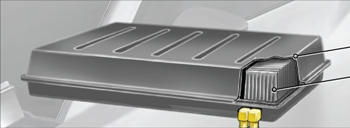To reduce the use of fossil fuels and to meet the growing demand for hybrid and electric vehicles, DuPont has introduced the first nanofiber-based polymeric battery separator that boosts the performance and safety of lithium ion batteries.
DuPont™ Energain™ battery separators can increase power 15 to 30 percent, increase battery life by up to 20 percent and improve battery safety by providing stability at high temperatures. With more battery power, drivers can travel farther on a single charge and accelerate more quickly and safely. For automobile and battery manufacturers, more battery power can reduce the number of batteries typically required in today’s hybrid and electric vehicles.
The company has begun construction on a facility in Chesterfield County, Va., to manufacture product for development and commercial sale.
 DuPont™ Energain™ separators boost performance and safety of lithium ion batteries. It's a sheet between two electrodes to prevent them from touching while letting lithium ions pass back and forth to allow the charge and discharge of the battery.
DuPont™ Energain™ separators boost performance and safety of lithium ion batteries. It's a sheet between two electrodes to prevent them from touching while letting lithium ions pass back and forth to allow the charge and discharge of the battery.
While the initial uses for the separator are in hybrid and electric vehicle batteries, the technology also will be targeted for batteries in renewable energy, grid applications, specialty consumer applications, including laptops, cell phones and power tools, among others. Other products made using DuPont’s proprietary nanofiber technology will target a broad range of liquid filtration applications for the biopharmaceutical, microelectronics, food and beverage industries, offering superior retention, filter life and flow resistance.
“This launch and our investment in a new production facility are important steps in our strategy to expand DuPont’s role in energy storage. What sets DuPont apart is integrated science and proven results for better, safer and more sustainable performance,” said Thomas G. Powell, president – DuPont Protection Technologies. “DuPont™ Energain™ is a breakthrough platform technology. We expect to translate the improvements we’ve seen in automotive battery applications to deliver equal or better battery performance in specialty consumer electronics, where reliable, faster and longer lasting battery power are essential.”
DuPont estimates that, by 2015, the market for high-performance lithium ion batteries alone will total more than $7 billion annually, primarily for electric vehicle applications and some photovoltaics and grid storage.
Typical hybrid vehicles contain between 50 and 70 batteries; plug-in electric vehicles with range-extending motors have 80 to more than 200 batteries; and fully electric vehicles carry 150 or more. Within each battery, the separator is a sheet positioned between the two electrodes. It functions as a barrier that prevents the electrodes from touching and shorting while letting lithium ions pass back and forth to allow the charge and discharge of the battery.
DuPont™ Energain™ battery separators are produced into a web using a proprietary spinning process that creates continuous filaments with diameters between 200 and 1,000 nanometers. The separators exhibit stability and low shrinkage in high temperatures and are highly saturable in electyrolyte liquids. The result is more efficient operation, longer battery life and improved safety. Batteries containing Energain™ separators can be quickly recharged, deliver improved performance and reduce the number of batteries needed by up to one-third for hybrid vehicles.
DuPont is working with a majority of the battery, equipment suppliers and automotive companies globally. The company has manufactured initial quantities of the separator material at sites in Wilmington, Del., and Seoul, South Korea. The new facility in Chesterfield County, Va., is expected to start up in the first quarter of 2011 and will initially be able to provide enough material to supply up to 20 percent of today's hybrid and electric vehicle needs.
DuPont produces more than 100 products used in every major vehicle system of a vehicle as well as a number of additional products for batteries, which can include fluoropolymer binder technology to hold together electrode materials; DuPont™ Kapton® tape and insulators in battery “jelly rolls,” to hold the layers together throughout production; DuPont™ Kalrez® elastomers to seal batteries and filling equipment; performance polymers such as DuPont™ Zytel® nylon in battery packs and control modules; DuPont™ ETPV and Vamac® elastomer in cable insulation to transfer electricity from battery packs to motors. Other applications in electric motors can include DuPont™ Vespel® parts for rotating bearing surfaces, DuPont™ Voltron® and Voltatex® wire enamels and varnishes, DuPont™ Nomex® aramid for insulating coatings, paper and film and Kapton® film for magnet wire insulation.
The DuPont™ Energain™ separators are the product of DuPont competencies in nanoscience, chemical engineering, fiber sciences, polymer synthesis, polymer modification and applications development. This broad range of expertise also is fueling the company’s research into and development of other energy storage technologies, including next-generation battery materials.
Source: http://www2.dupont.com/